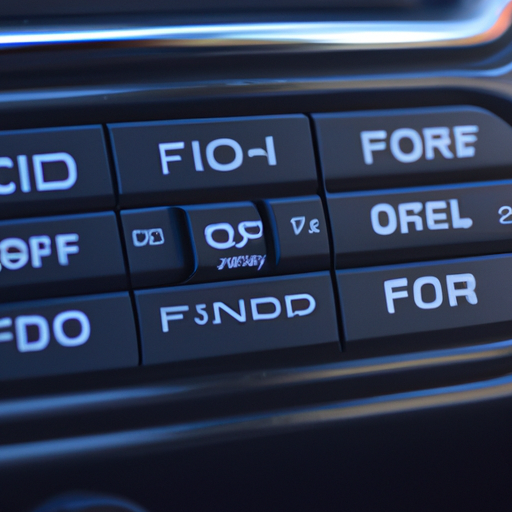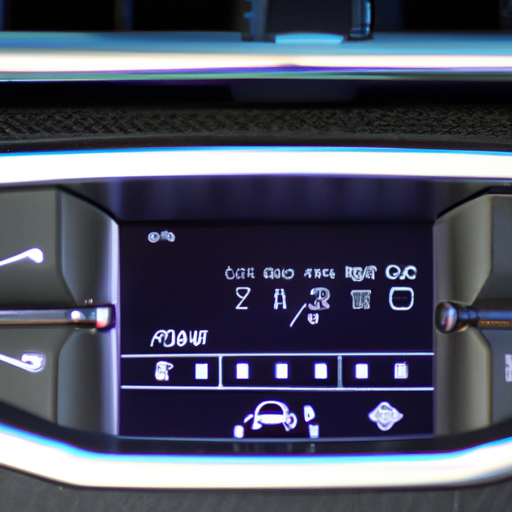Are you the proud owner of a 2017 Ford F-250? If so, you might want to pay attention to the instrument cluster in your vehicle. Unfortunately, there have been some reported problems with the instrument cluster in the 2017 Ford F-250. This article will explore the common issues that have been reported, providing you with the necessary information to understand and address any potential problems you may encounter with your instrument cluster. So, let’s get started and ensure that your driving experience remains smooth and worry-free.

Common Issues with 2017 Ford F-250 Instrument Cluster
Blank or Frozen LCD Display
One of the most common problems reported with the 2017 Ford F-250 instrument cluster is a blank or frozen LCD display. This can make it difficult or even impossible to read important information such as speed, mileage, and fuel levels. A blank or frozen display is often caused by a software glitch or a faulty connection.
Inaccurate or Unresponsive Gauges
Another issue that owners of the 2017 Ford F-250 may encounter is inaccurate or unresponsive gauges. This means that the gauges on the instrument cluster may not accurately reflect the actual conditions of the vehicle, such as the fuel level or engine temperature. In some cases, the gauges may even remain completely still or fail to respond to changes in the vehicle’s status.
Intermittent Power Loss
Intermittent power loss is a frustrating problem that some F-250 owners have experienced with their instrument clusters. This can result in a sudden loss of power to the instrument cluster, causing the gauges, warning lights, and LCD display to stop working. The power loss may come and go, making it difficult to diagnose and fix the issue.
Erratic Warning Lights
Many owners have also reported issues with erratic warning lights on their 2017 Ford F-250 instrument clusters. These warning lights may turn on and off randomly or provide false information about the vehicle’s status. This can be particularly concerning if important warning lights, such as the check engine light or the brake system warning light, are affected.
Dim or Flickering Backlight
Dim or flickering backlight is another issue that some F-250 owners have encountered with their instrument clusters. This can make it difficult to read the information displayed on the instrument cluster, especially in low-light conditions. The backlight may dim or flicker intermittently, impacting visibility and potentially causing eye strain.
Difficulty Starting the Vehicle
While not directly related to the instrument cluster itself, some owners have reported difficulty starting their 2017 Ford F-250 vehicles, which may be attributed to instrument cluster malfunctions. If the instrument cluster fails to properly recognize the vehicle’s key or transmit the necessary signals to the engine control unit, it can result in starting problems.
Loss of Instrument Cluster Functions
In more severe cases, the entire instrument cluster may lose functionality, rendering it completely useless. This means that all the gauges, warning lights, and the LCD display stop working, leaving the driver without crucial information about the vehicle’s performance and status.
Malfunctioning Odometer or Trip Display
Some owners have also reported problems with the odometer or trip display on their 2017 Ford F-250 instrument clusters. These displays may show incorrect mileage, fail to update properly, or cease to function altogether. A malfunctioning odometer can make it challenging to keep track of the vehicle’s usage and maintenance schedule accurately.
Software Malfunctions
Software glitches or bugs can also be a potential cause of instrument cluster problems in the 2017 Ford F-250. These software malfunctions can lead to various issues, including frozen displays, inaccurate gauges, and malfunctioning warning lights. Updating or resetting the instrument cluster software may often resolve these software-related problems.
Potential Safety Concerns
Instrument cluster issues may pose potential safety concerns for 2017 Ford F-250 owners. If warning lights are not functioning correctly, drivers may not receive proper alerts for critical vehicle malfunctions. Inaccurate gauges, such as the fuel gauge or temperature gauge, can also lead to unexpected breakdowns or hazardous situations on the road. Therefore, addressing these instrument cluster problems promptly is essential to ensure the safety of the driver and passengers.
Causes of Instrument Cluster Problems
Faulty Wiring or Connectors
Faulty wiring connections or connectors can be a common cause of instrument cluster problems. Over time, the wiring may become damaged or loose, leading to intermittent power loss or other issues. Ensuring that all wiring connections are secure and free from any damage can help prevent instrument cluster malfunctions.
Software Glitches or Bugs
Software glitches or bugs within the instrument cluster’s programming can contribute to various problems. These glitches can cause the display to freeze, gauges to malfunction, or warning lights to behave erratically. Regularly updating the instrument cluster software can help mitigate these software-related issues.
Electrical System Issues
Issues with the vehicle’s electrical system, such as a faulty alternator or battery, can affect the instrument cluster’s performance. Insufficient voltage or power supply can lead to dim backlighting, unresponsive gauges, or intermittent power loss. Addressing and resolving any electrical system problems can help prevent instrument cluster malfunctions.
Instrument Cluster Circuit Board Failures
The instrument cluster circuit board, which houses the electrical components and connects them to the vehicle’s wiring, can fail over time. This can be due to factors such as age, heat, or manufacturer defects. A faulty circuit board can result in a range of instrument cluster issues and may require replacement or repair.
Sensor Malfunctions or Failures
The sensors that provide data to the instrument cluster, such as the fuel level sensor or the engine temperature sensor, can malfunction or fail. This can cause inaccurate gauge readings or other instrument cluster problems. Inspecting and replacing faulty sensors can help resolve these issues.
Voltage or Power Supply Problems
Inadequate voltage or power supply to the instrument cluster can lead to various malfunctions. This can be caused by a faulty battery, alternator, or wiring. Checking the battery voltage and the charging system’s performance can help identify and address any voltage or power supply problems.
Physical Damage or Impact
Physical damage or impact to the instrument cluster, such as from a collision or rough handling, can result in instrument cluster problems. This can include cracked displays, dislodged components, or damaged wiring. Taking precautions to protect the instrument cluster from physical damage and addressing any impacts promptly can help prevent malfunctions.
Manufacturer Defects
Some instrument cluster problems may be due to manufacturer defects. These defects can range from faulty components to design flaws. Checking for any recalls or service bulletins related to the instrument cluster can help identify and resolve any manufacturer-related issues.
Environmental Factors
Extreme temperatures, humidity, or exposure to moisture can also contribute to instrument cluster problems. These environmental factors can impact the performance of electrical components, display panels, or circuit boards. Protecting the instrument cluster from extreme temperatures and moisture can help prevent malfunctions.
Overheating
Overheating can be a potential cause of instrument cluster problems. If the instrument cluster becomes overheated, it can lead to circuit board failures, display malfunctions, or unresponsive functions. Ensuring adequate ventilation and optimal operating conditions can help prevent overheating.

Symptoms of Instrument Cluster Problems
LCD display not working or frozen
A common symptom of instrument cluster problems is a non-working or frozen LCD display. The display may remain completely black or fail to update the information being displayed. This can make it difficult or impossible to read vital information about the vehicle’s performance and status.
Incorrect or erratic gauge readings
Inaccurate or erratic gauge readings are another key symptom of instrument cluster problems. The gauges may show incorrect information or behave unpredictably. For example, the fuel gauge may indicate a full tank when it is actually empty, or the temperature gauge may fluctuate rapidly without any corresponding changes to the engine temperature.
Power loss to numerous instruments
Intermittent or complete power loss to various instruments, such as gauges, warning lights, or the LCD display, is a significant symptom of instrument cluster problems. The loss of power can be sudden and may come and go unexpectedly, making it challenging to diagnose and fix the issue.
Warning lights behaving abnormally
Abnormal behavior of warning lights can also indicate instrument cluster problems. The warning lights may turn on and off randomly or provide inaccurate information about the vehicle’s status. This can be concerning if important warning lights, such as the check engine light or the brake system warning light, are affected.
Backlight dimming or flickering
Dimming or flickering backlight is a noticeable symptom of instrument cluster problems. The backlight may appear dim or flicker intermittently, making it difficult to read the information displayed on the instrument cluster. This can impact visibility, especially in low-light conditions.
Engine not starting or stalling
While not directly related to the instrument cluster, difficulty starting the vehicle or engine stalling can be indicative of instrument cluster malfunctions. If the instrument cluster fails to recognize the vehicle’s key or transmit the necessary signals to the engine control unit, it can result in starting problems or engine misfires.
Inability to access certain features or settings
Instrument cluster problems may also manifest as the inability to access certain features or settings. This can include functions such as adjusting the clock, changing display settings, or accessing vehicle information menus. The instrument cluster may fail to respond to commands or display error messages.
Discrepancies in trip or odometer readings
Discrepancies in trip or odometer readings can be a symptom of instrument cluster problems. The trip or odometer may show incorrect mileage or fail to update properly. This can make it challenging to track the vehicle’s usage accurately or plan for necessary maintenance.
Unresponsive or slow software functions
Unresponsive or slow software functions within the instrument cluster can indicate underlying problems. The software may fail to respond to commands promptly or experience slow processing times. This can impact overall usability and functionality.
Safety features not working properly
Instrument cluster problems can also affect the proper functioning of safety features. For example, if the instrument cluster fails to recognize a critical vehicle malfunction, important warning lights may not turn on to alert the driver. This can compromise the safety of the driver and passengers.

Diagnostic and Troubleshooting Steps
Check for Loose or Damaged Wiring Connections
When experiencing instrument cluster problems, it is important to start by checking for loose or damaged wiring connections. Inspecting the wiring harnesses and connectors for any signs of damage or poor connections can help identify and resolve these issues.
Use Diagnostic Tools to Read Error Codes
Using diagnostic tools such as OBD-II scanners can provide valuable error codes that can help pinpoint the cause of instrument cluster problems. These error codes can guide the troubleshooting process and narrow down potential root causes.
Perform a Cluster Self-Test
Many modern vehicles, including the 2017 Ford F-250, have a built-in self-test feature within the instrument cluster. This self-test can help identify any internal malfunctions or errors within the instrument cluster. Accessing and performing the cluster self-test following the manufacturer’s instructions can provide valuable diagnostic information.
Inspect Fuse for Instrument Cluster
A blown fuse can cause the instrument cluster to stop functioning. Checking the fuse for the instrument cluster and replacing it if necessary can often resolve power-related issues.
Reset or Update Instrument Cluster Software
Performing a reset or updating the instrument cluster software can help resolve software-related problems. This can often be done using specialized dealer equipment or following the manufacturer’s instructions for software updates.
Replace Faulty Sensors or Components
In cases where faulty sensors or components are identified as the cause of instrument cluster problems, replacing these components can help restore proper functionality. This may involve replacing sensors such as the fuel level sensor or the engine temperature sensor.
Examine Battery Voltage and Charging System
Checking the battery voltage and the charging system’s performance can help identify any voltage-related issues that may be affecting the instrument cluster. Ensuring that the battery is functioning correctly and the charging system is providing adequate power can help prevent instrument cluster malfunctions.
Inspect and Clean Ground Connections
Corroded or loose ground connections can contribute to instrument cluster problems. Inspecting and cleaning the ground connections can help ensure proper electrical connections and prevent malfunctions.
Verify Instrument Cluster Compatibility
If considering replacing or upgrading the instrument cluster, it is important to verify compatibility with the vehicle’s make and model. Different instrument clusters may have subtle variations in wiring connections or software programming, which can lead to compatibility issues if not properly addressed.
Consult with a Professional Mechanic
If the troubleshooting steps mentioned above do not resolve the instrument cluster problems, it is recommended to consult with a professional mechanic. They have the knowledge, experience, and specialized equipment to diagnose and repair more complex instrument cluster issues.

Common Fixes and Solutions
Repairing or Replacing Faulty Wiring
In cases where faulty wiring is identified as the cause of instrument cluster problems, repairing or replacing the wiring harnesses or connectors can help restore proper functionality. This can involve soldering damaged wires, replacing damaged connectors, or rewiring the affected areas.
Updating or Resetting Instrument Cluster Software
Updating or resetting the instrument cluster software can often resolve software-related instrument cluster problems. This can be done by visiting a dealership or using specialized diagnostic software to ensure the latest software version is installed.
Replacing Malfunctioning Sensors or Components
Replacing malfunctioning sensors or components can help resolve instrument cluster problems directly attributed to these specific parts. This can involve replacing sensors such as the fuel level sensor, the engine temperature sensor, or the speed sensor.
Replacing Faulty Instrument Cluster Circuit Board
If the instrument cluster circuit board is determined to be the source of the problems, replacing the faulty circuit board can fix the instrument cluster issues. This typically requires removing the instrument cluster, disassembling it, and replacing the circuit board with a new or refurbished one.
Disabling and Reenabling Safety Features
In some cases, temporarily disabling and then reenabling safety features within the instrument cluster may help resolve certain malfunctions. This can involve accessing the vehicle’s settings menu or following specific instructions provided by the manufacturer.
Calibrating Gauges and Instrument Cluster Settings
Calibrating the gauges and instrument cluster settings can help ensure accurate readings and proper functionality. This can involve following manufacturer instructions or using specialized diagnostic equipment to calibrate the various instrument cluster components.
Addressing Battery or Power Supply Issues
Ensuring the battery and power supply are functioning correctly can help prevent instrument cluster problems related to insufficient power. This can include replacing a faulty battery, repairing the charging system, or upgrading the electrical system components.
Replacing or Upgrading the Instrument Cluster
In some cases, replacing or upgrading the entire instrument cluster may be necessary to resolve persistent and severe instrument cluster problems. This typically involves sourcing a compatible replacement or upgraded instrument cluster and following manufacturer instructions for installation.
Checking for Manufacturer Recalls or Service Bulletins
Checking for any manufacturer recalls or service bulletins related to instrument cluster problems can help identify any known issues and potential solutions. Manufacturers may provide free repairs or replacement parts for specific instrument cluster problems.
Proper Maintenance and Regular Inspection
Proper maintenance and regular inspection of the instrument cluster can help prevent problems before they occur. This includes keeping the instrument cluster clean, checking for loose or damaged connections, and following the manufacturer’s recommended maintenance schedule.

Preventive Measures to Avoid Instrument Cluster Issues
Schedule Regular Maintenance and Inspections
Scheduling regular maintenance and inspections for the instrument cluster can help prevent problems and catch any potential issues early on. This includes following the manufacturer’s recommended maintenance schedule and having a professional mechanic inspect the instrument cluster during routine services.
Keep Wiring and Connectors Clean and Secure
Keeping the wiring and connectors clean and secure can help prevent instrument cluster problems caused by loose or damaged connections. Regularly inspecting and cleaning the wiring harnesses and connectors can help maintain proper functionality.
Avoid Overloading the Electrical System
Avoiding overloading the electrical system can help prevent instrument cluster problems related to voltage or power supply issues. This includes not exceeding the vehicle’s specified electrical load capacity and using electrical accessories responsibly.
Drive Responsibly to Minimize Impact Damage
Driving responsibly and avoiding accidents or impacts can help prevent physical damage to the instrument cluster. Taking precautions such as maintaining a safe distance from other vehicles, avoiding rough terrains, and ensuring proper vehicle maintenance can minimize the risk of impact damage.
Protect Instrument Cluster from Extreme Temperatures
Extreme temperatures can adversely affect the instrument cluster’s performance. Taking steps to protect the instrument cluster from extreme heat or cold, such as parking in shaded areas or using sunshades, can help prevent malfunctions.
Be Proactive in Addressing Warning Signs
Being proactive and addressing any warning signs of instrument cluster problems promptly can help prevent further damage or complications. If any symptoms or abnormalities are noticed, it is important to take the necessary steps to diagnose and resolve the issues.
Keep Software and Firmware Updated
Regularly updating the instrument cluster software and firmware can help prevent software-related instrument cluster problems. This can be done by visiting a dealership or following the manufacturer’s instructions for software updates.
Avoid Tampering with Electrical Components or Modifications
Avoiding tampering with electrical components or unauthorized modifications to the instrument cluster can help prevent instrument cluster problems. Modifying the instrument cluster or its wiring without proper knowledge and expertise can lead to malfunctions and void warranties.
Follow Manufacturer Guidelines for Aftermarket Accessories
If considering installing aftermarket accessories or modifications that may affect the instrument cluster, it is important to follow the manufacturer’s guidelines. Improperly installed accessories can interfere with the instrument cluster’s functionality and lead to malfunctions.
Address Any Electrical or Wiring Issues Promptly
Addressing any electrical or wiring issues promptly can help prevent further problems, including instrument cluster malfunctions. If any electrical or wiring problems are suspected, it is recommended to have a professional mechanic inspect and repair them as soon as possible.
By following these preventive measures and taking the necessary steps to diagnose and resolve instrument cluster problems, 2017 Ford F-250 owners can ensure the smooth and reliable operation of their instrument clusters. Regular maintenance, proper care, and addressing any issues promptly can help prevent costly repairs and ensure a safe driving experience.
